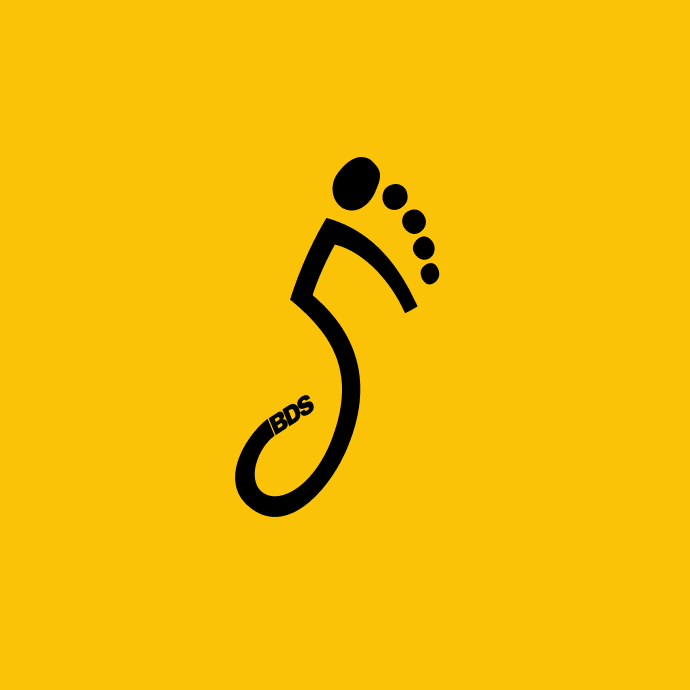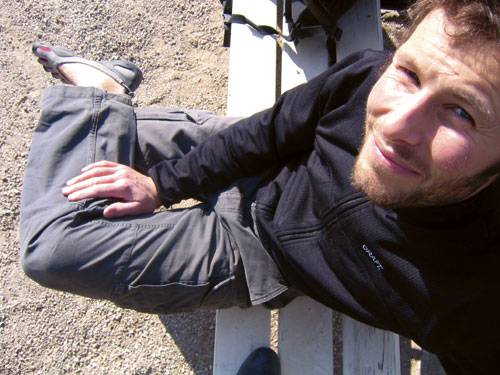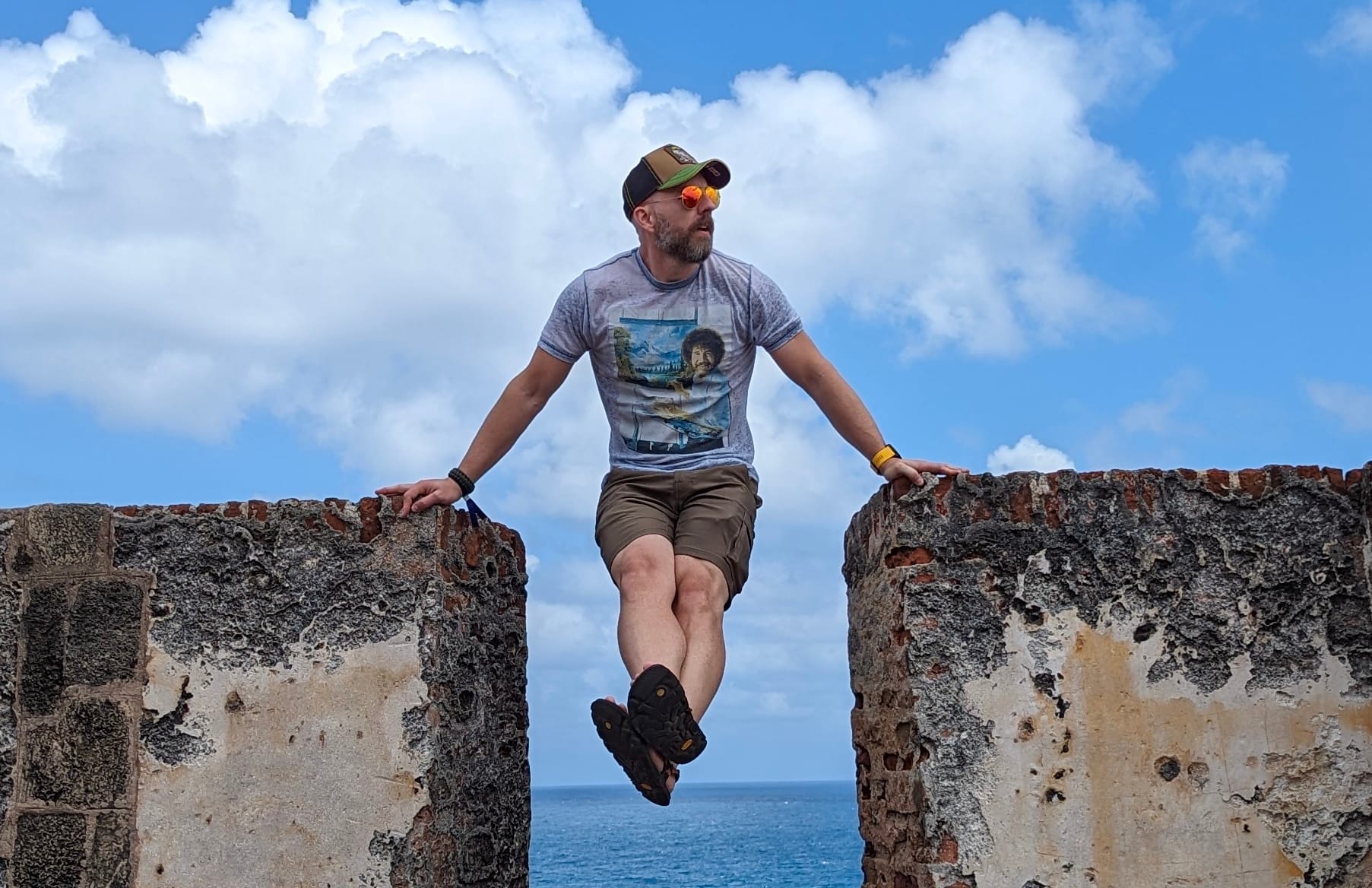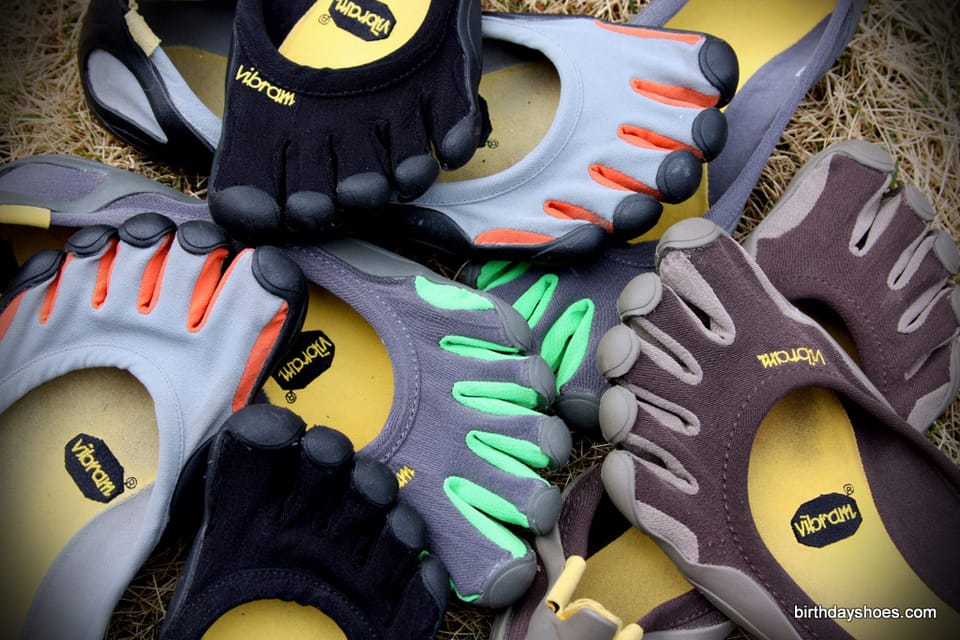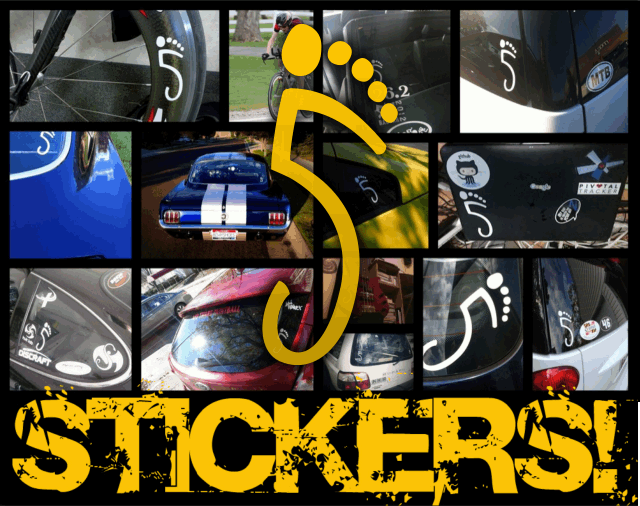Why toe shoes?
An essay into designing footwear that maximizes the minimalist experience — examining the functional needs of the foot and how shoes like moccasins and sandals like huaraches stack up. Why toe shoes come out on top.
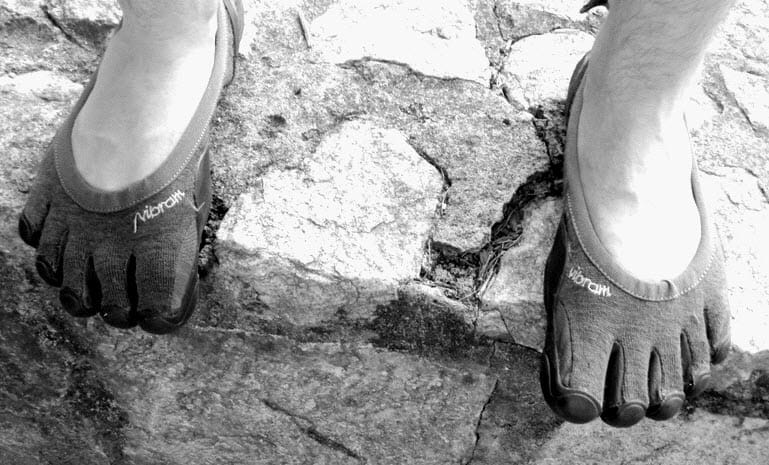
"What are those ... toe shoes?" This is one of the first questions that runs through the minds of someone when they see those "shoes that look like feet" — "toe shoes" — for the first time. And no, I'm not talking about ballet shoes nor "steel toe shoes," but the latest iteration of footwear, complete with articulated toe pockets.
I'm talking about the pioneers of toe shoes — Vibram FiveFingers. FiveFingers showed up around 2006 and could be said to have spawned the whole "barefoot running shoes" minimalist shoes market single-handedlyfootedly. I'm also talking about Fila Skele-toes, which arrived in early 2011. And then came the Adidas Adipure Trainers in Fall 2011.
By year's end 2011, there were no fewer than five manufacturers of shoes with toes. (Fast-forward to 2025 and there are many more — and many that have disappeared since.)
The question: "What are those ... toe shoes?" begs a bigger question:
Why toe shoes?
And to answer this question, we start at first principles by asking:
"What's the purpose of a shoe, anyway?"
To answer this, we approach the question from the perspective of function (form being assumed subjective). Shoes exist to support the function of the foot and the movement of the human body.
Now we're getting somewhere. And here is where we enter the world of "barefoot shoes" or "minimalist footwear," of which "toe shoes" are perhaps the most popular iteration.
What are "barefoot shoes"?
Minimalist and barefoot-style shoes aim to preserve the foot's natural or innate function — from the foot's sensitivity to how it can move to the separation of the toes.
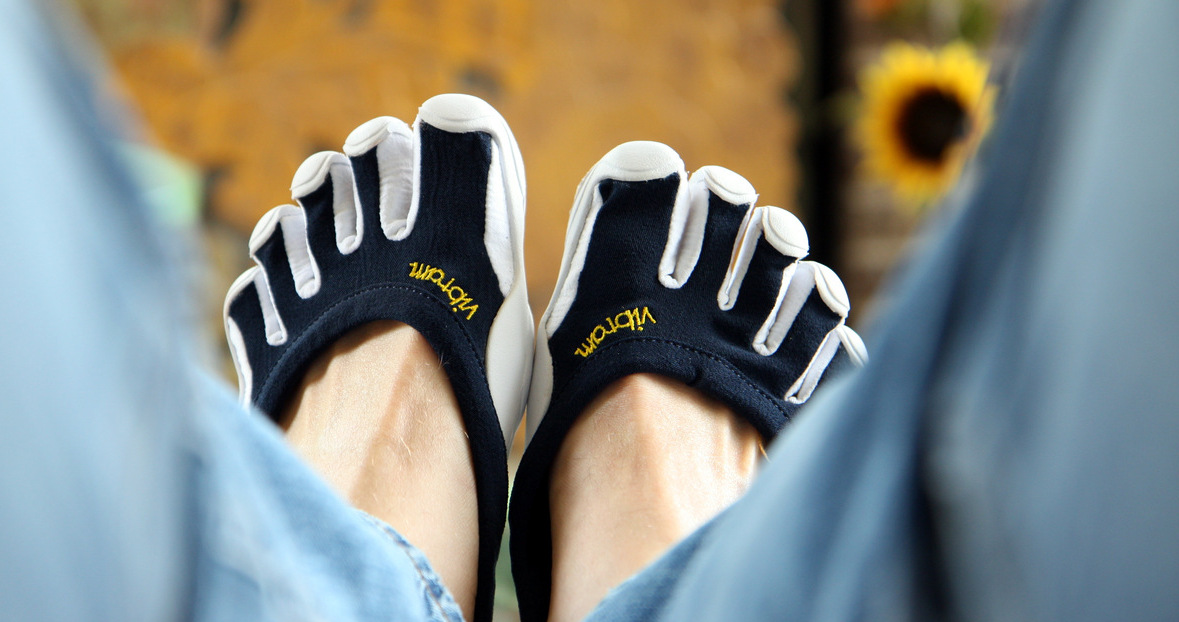
You might also want to bookmark this post 🔖
What are "toe shoes"?
Toe shoes are special foot gloves that combine some form of sole material (e.g. Vibram rubber) and a design that allows for the separation of each individual toe.
For both barefoot shoes and toe shoes, the aim is to let feet be feet in all their dynamic, sensational glory. The belief is that using footwear that supports natural movement encourages a healthier engagement with the world, starting from the ground up. The expectation is for wearers of toe shoes and other barefoot or minimalist footwear to have stronger feet and legs, to learn smarter movement patterns, and to incur less injury and even less pain.
You might think of "toe shoes" like a square as to the rectangle of "barefoot shoes." Both are similar, and both are helpful. But to understand how they differ, we need to go deeper — including discussion of prevailing types of footwear. And before that, we should examine the most common types of footwear.
That way we understand better what barefoot shoes and toe shoes are not.

How normal shoes fail to work
When you think about it, it's obvious that shoes aren't necessary for getting about — we can run and walk and play barefoot without injuring ourselves. If this wasn't true, the human race would have likely gone extinct a long time ago. The bottom line is that we are born barefoot, that Nikes and all modern footwear (having elevated heels, cushioned soles, etc.) have only been around for hundreds of years. The emergence of Homo erectus was something like 1.3 to 1.8 million years ago with homo sapiens emerging a couple hundred thousand years back.
Barefoot is the default human condition whereas shoes are a technology created by humans to adapt to different surfaces.
If barefoot is the default state of our feet, it follows that the default design of footwear should be to support that state — e.g., providing benefit to the foot (protection, insulation, or even style) while still allowing for the default (bare) function of the foot.
The default design of footwear should be to support that state — e.g., providing benefit to the foot (protection, insulation, or even style) while still allowing for the default (bare) function of the foot.
But most shoes don't do this at all. Modern shoes have hard soles — or thick cushy soles. Shoe lasts (the "last" is the shape of the interior of the shoe) are shaped like wedges elevating our heels. Modern shoes ram our toes into narrowing boxes. Some shoes use springs or air to bounce us from step to step while others intentionally make us walk funny to tone our butts. Shoes that allow for feet to flex dynamically with each step and sense the ground — they are the exception.
The naked human foot is a bone-filled, muscular, nerve-laden body part; one that has five appendages (toes) and interacts dynamically with the earth in all its variations. It does this thousands upon thousands of times a day each time bearing our brute weight multiple times over. Creating a shoe that allows for the full dynamic functionality of a bare foot would be an incredible feat of engineering.
What typically happens when we add to our naked feet—our "birthday shoes"—prosthetics in the form of external soles is that the natural state of the foot is circumvented and the foot and body are forced to compensate in often weird and painful ways. Somewhere down the line things start to fall apart.
Feet are complicated and alive; shoes are dead and simple; can we even design a "smart" shoe?
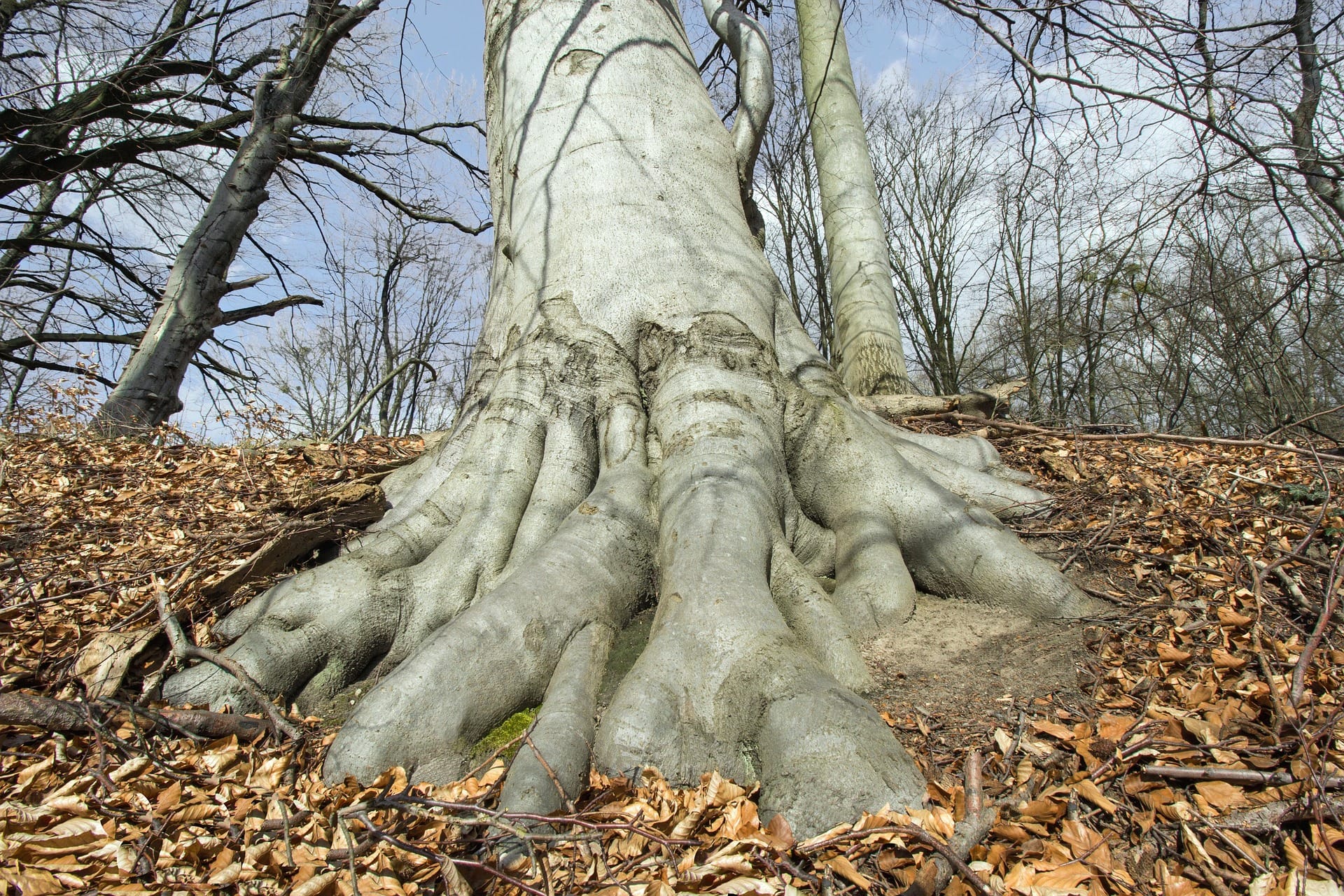
How should a shoe support natural foot movement and function?
Can a shoe be designed that simultaneously improves on the default state of the bare foot while still letting it function naturally?
We are finally finding out. Over the last several years, we have seen real experimentation in shoe design and manufacturing in support of foot-friendly footwear.
So what makes a shoe "foot-friendly"? Below I'll explore a few expectations to consider. But you will — and must — make your own determination as to what's important for the strength of your feet, your body, and your mind.
As for me, I'll disclaim my bias: I'm skeptical any shoe (as yet in existence or theoretical) could support the naked functionality of the bare foot. But I wear shoes every day for all kinds of purposes, and I'm not dogmatic about them meeting all the below design requirements.
Because like Walt Whitman, "I am large, I contain multitudes" — and you do too.
Barefoot shoe design requirement No. 1:
Support foot movement
Feet flex and bend and have toes that splay naturally without any conscious effort with every step taken.
Toes give your foot purchase on the ground as they expand, stabilizing the foot with an instantly customized grip—like the roots of a tree. How do you replicate this rooting of the foot while wearing a shoe?
With a thick tendon at the heel (the Achilles) and all the arch-supporting internal musculature and bones, our feet and legs are awesome springs — pistons perhaps. How do you maintain the springy energy caught via the elastic design of the arch or the rubber band-like tendons?
Supporting foot movement likely means that shoes should be lightweight and keep your feet literally close to the ground.
Barefoot shoe design requirement No. 2:
Allow feet to feel the ground
Feet are sensitive. Test this out by taking off all footwear and walking outside onto pavement or concrete. If you own a pair of minimalist shoes like Vibram FiveFingers and haven't done this, you really need to take a moment and go outside barefooted. Do it already.
The sensations you'll experience actually barefoot are profound even relative to what you feel wearing a pair of minimalist shoes (like Vibram FiveFingers Classics or Soft Star Mocs). Your feet will feel the rough texture of the cement and the dustiness of the dirt. As you walk around barefoot you'll find yourself stepping more gingerly; you'll adjust your gait without even paying much attention to it. In the event that you step on something sharp you will instantly correct your weight and reduce impact (and avoid pain). It's instant, natural, and sorta awesome.
The sensations in your feet direct how you step. The sensitivity of the foot, perhaps more than anything else, is why running barefoot teaches you proper, impact-reduced form. Abrasive friction (dragging your feet across the ground, pulling, or pushing the pads of your feet against the earth) will cause damage. A bare foot is susceptible to being rubbed raw if friction isn't minimized. And of course there's the risk of stepping on a sharp pebble or rock that could puncture the foot, but those are one-off problems often avoidable by a watchful eye.
One of the biggest selling points of a shoe is that they protect the foot, but the protection of a shoe comes at a price. Protection impairs the sensitivity of our feet, reducing the need to minimize friction against the earth.
Is it possible for a shoe to both protect the foot without muting feedback from the ground?
Barefoot shoe design requirement No. 3: Support the proprioception of the foot
Beyond just experiencing the ground directly, our feet have an awareness of where they are with respect to the rest of the body and surrounding objects. This perception of space is called proprioception. Feet sense their place in space.
Proprioceptive sense reminds me of being coordinated. Proprioception is what makes it seem easy to perform delicate procedures quickly and without conscious effort. It enables us to catch an accidentally dropped glass before it crashes and facilitates touch-typing 100 words per minute without looking at a keyboard. How is the proprioceptive sense of the foot maintained when wrapped in a shoe?
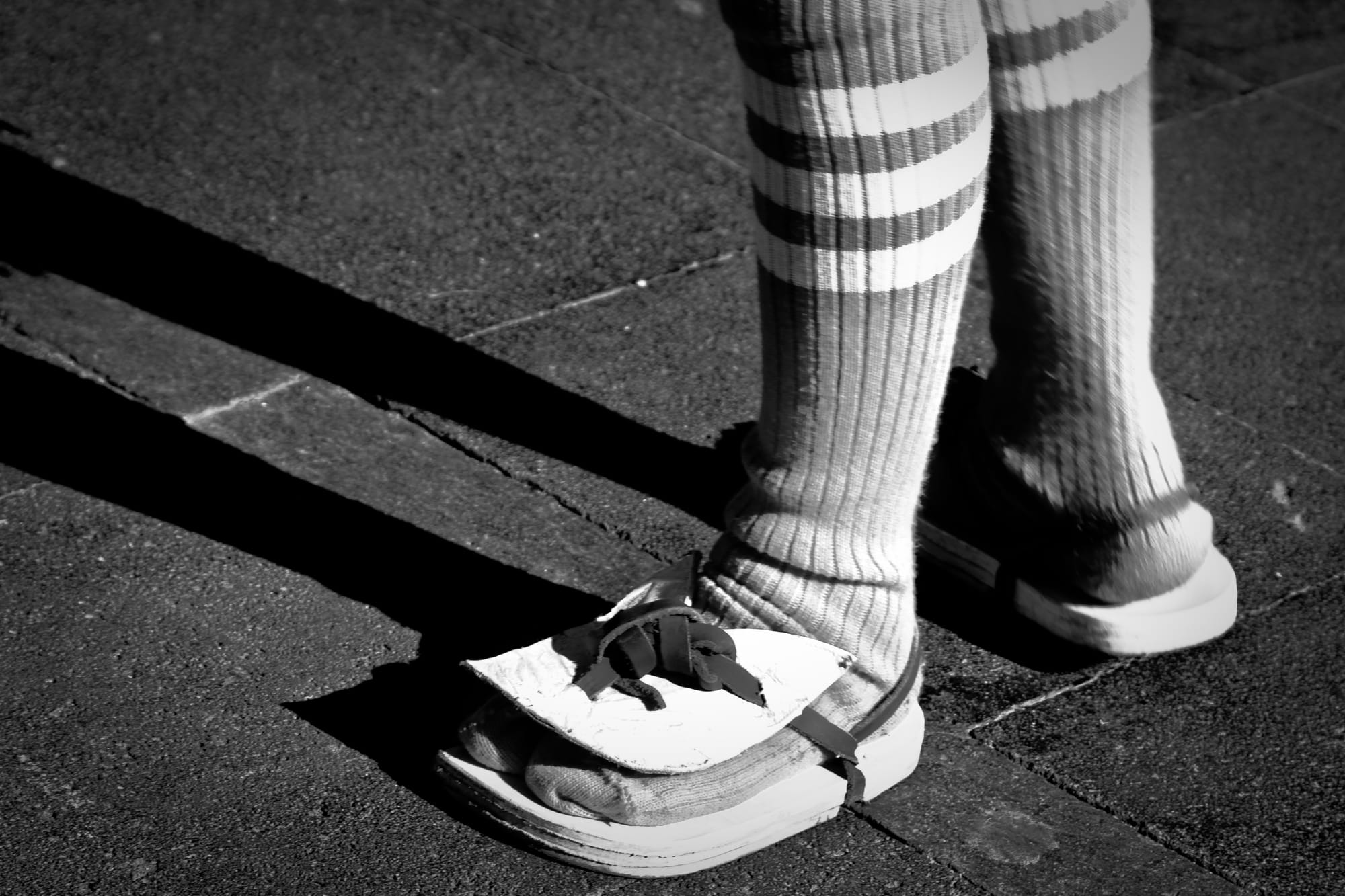
Footwear should get out of the way of feet
Taking the above general criteria and applying them to footwear, a barefoot-supporting shoe must:
- Allow the foot to feel the ground — not simply because the ground is interesting to feel, but because sensing the ground directs the foot how to step.
- Allow the foot to sense it's surroundings — just as clown shoes would be extremely clumsy as they would extend far past the ends and sides of the foot, so must functional shoes fit well enough that a foot's sense of it's surroundings remains intact.
- Allow the foot to move naturally — if the arch of the foot wants to flex (like a bow) as it bears your weight, then a shoe should let it. If your toes want to splay out on impacting the ground, they should be free to do so. If they want to flex upward, that, too, must be considered.
These criteria are simple enough, right? Just remember why we're even bothering with shoes in the first place: protection. How do we add protection and provide for function?
Two primary solutions have been offered to solve this problem: toe shoes and traditional, mono-toed shoes. Let's talk about both — and I'll finally argue why I think toe shoes are the present, best solution for minimalist footwear.
Thin-soled foot mittens vs. minimalist sandals
What can we learn from mankind's history about footwear? Take a look at these ancient forms of footwear — five thousand year old leather shoes:

Moccasins are an ancient form of footwear, and while this may not be the canonized truth, this factoid on moccasins from Wikipedia seems to nail their purpose: "Moccasins protect the foot while allowing the wearer to feel the ground."
It's remarkable how little improved modern shoes are from the ancient design of a leather moccasin. Mocs work extraordinarily well as protective coverings for the feet that still allow the foot to function naturally. They are roomy on the inside, transmit a great deal of ground feel due to the sole being leather or fabric, and are neutral from heel-to-toe.

Fast forward to today and you can get some truly retro-yet-updated Soft Star, fabric-soled, sheepskin lined Moccasins; or for a slightly less-soft experience the RunAmocs, which feature a Vibram rubber sole. These represent a modern moccasin. These mocs function as expected—zero foot support, zero-drop from heel to toe, and a great deal of ground feel (an enormous amount for the fabric-soled varieties like Roo or Grippy Roo). These are great "barefoot shoes" so long as you don't mind the aesthetic of a moccasin.
Moccasins aren't the only ancient, low-tech options. Take the huaraches sandals of the Tarahumara Indians, for example. Huaraches are little more than a thin strip of sole material custom-cut to your foot size with a single lace to attach them to your feet. How's that for minimal? And if you're looking for a minimalist sandal that is foot friendly, grab a tire and some string and roll your own. Want a pre-made kit to make your own? Try the Xero Shoes or go fancy and get some leather-strapped LUNA Sandals from Barefoot Ted. These days there are tons of huaraches brands to choose from.
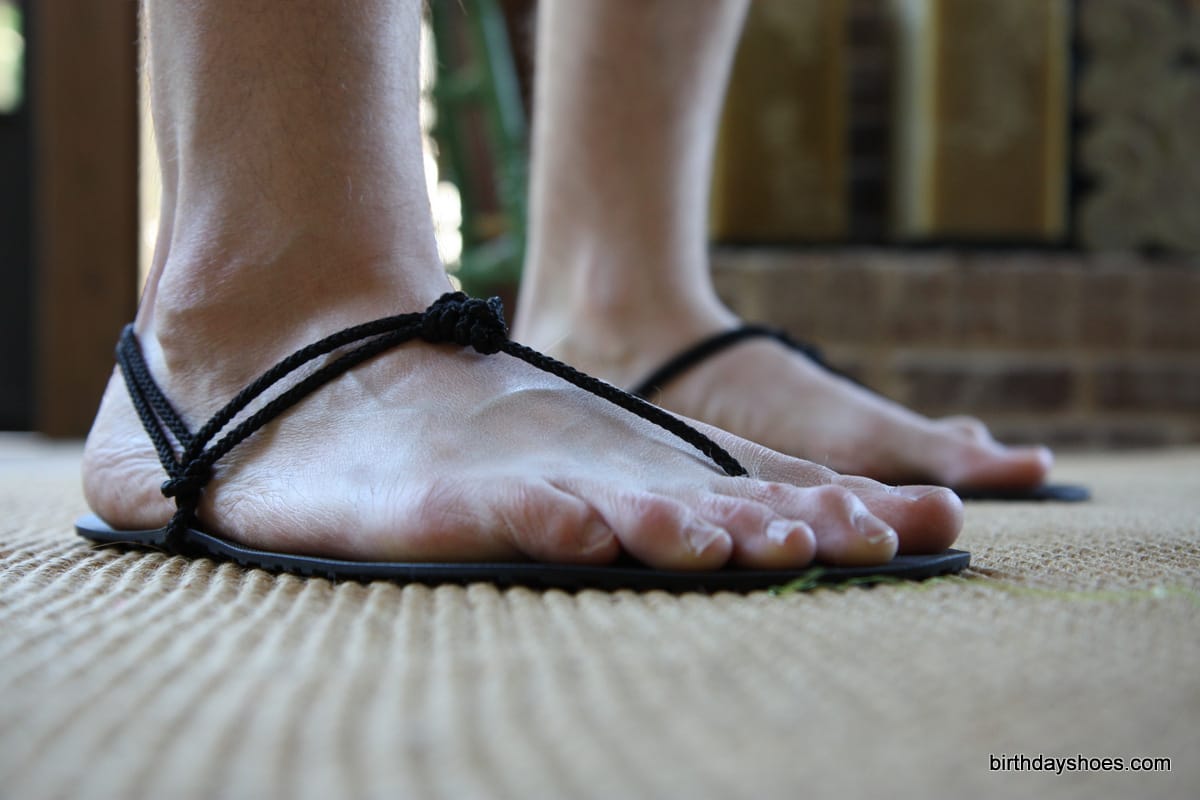
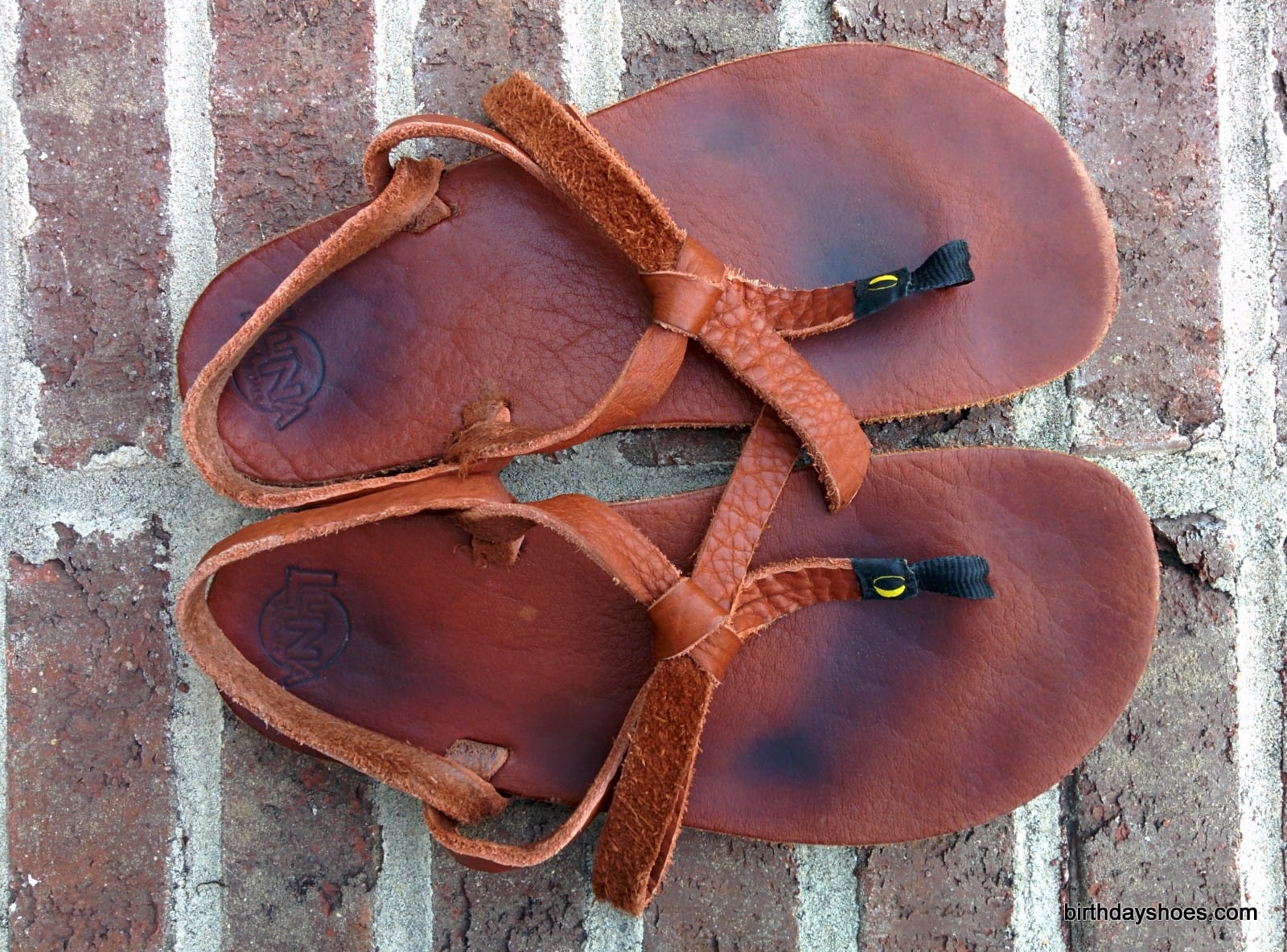
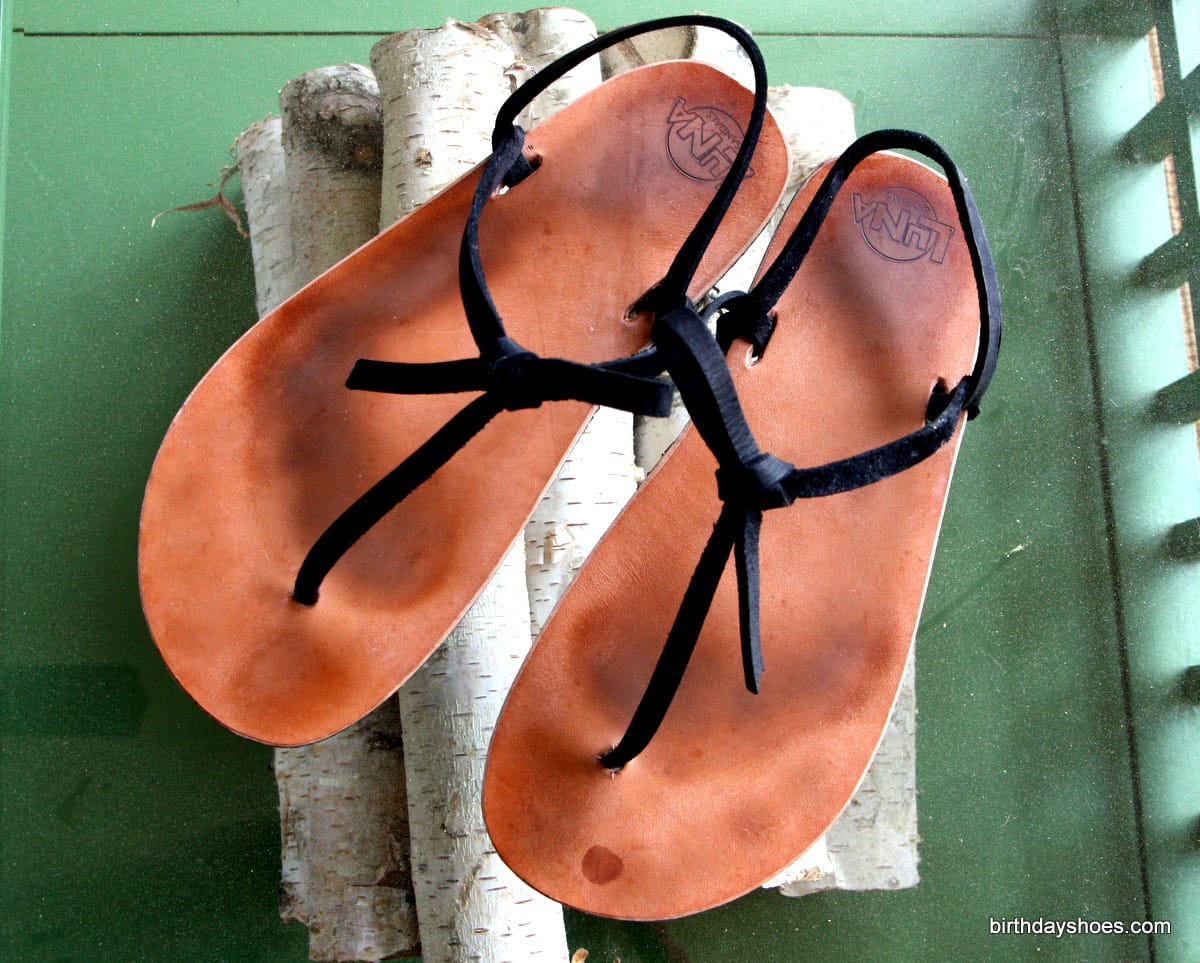
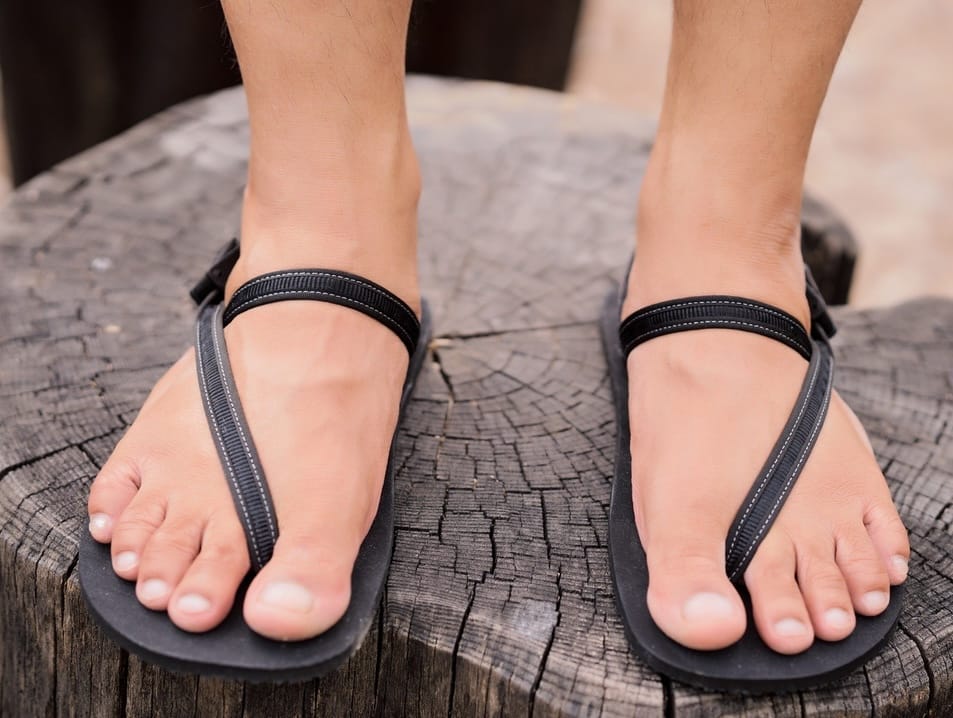
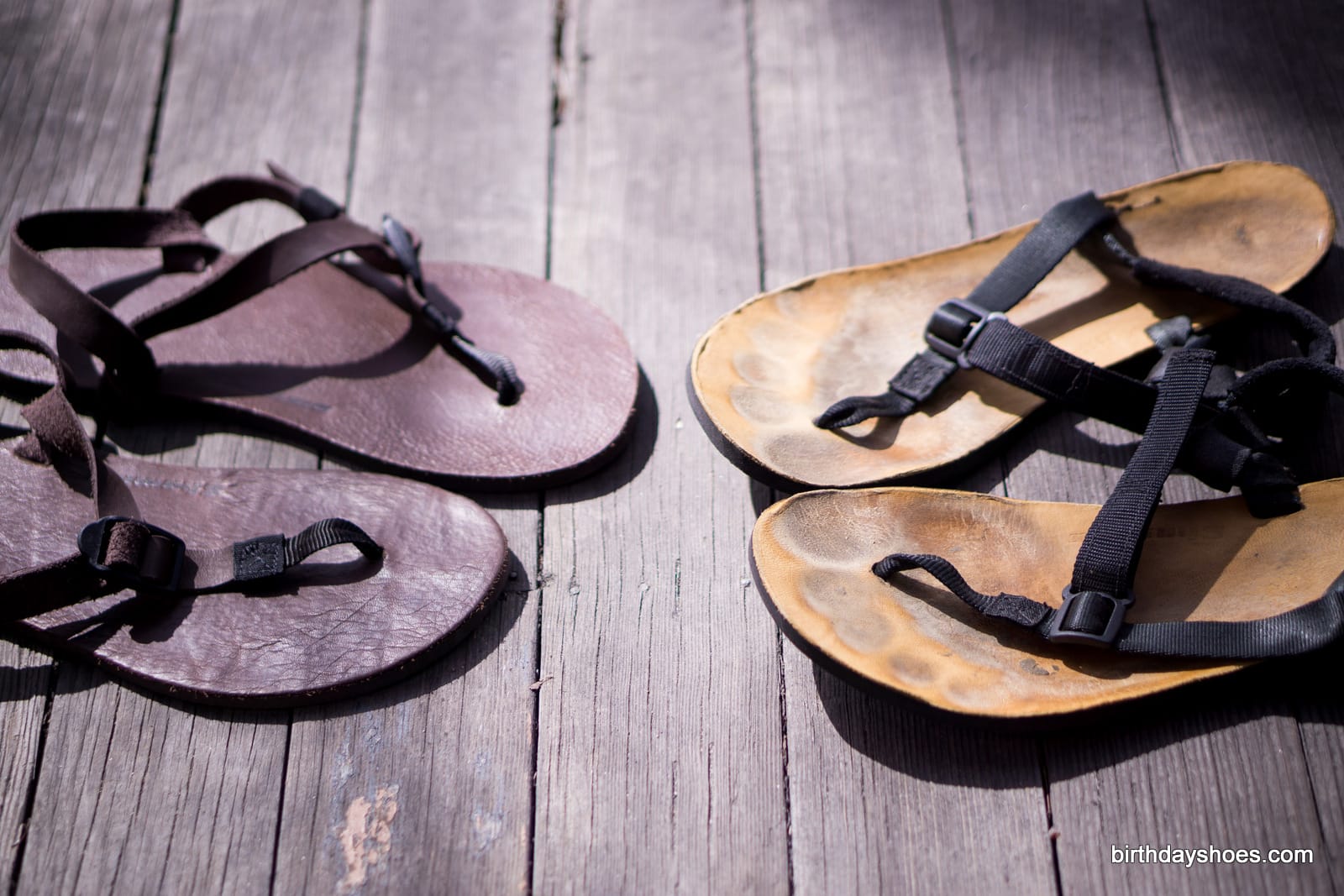

There are many types of huaraches and huaraches-inspired sandals available today, from DIY Xero Shoes (top left) to LUNA sandals (top middle, top right), to EarthRunners (bottom left), to Shamma Sandals (bottom middle) to Bedrock Sandals (bottom right) — and more huaraches here.
Beyond low-tech, old-school footwear solutions like huaraches and moccasins, there are, of course, modern, foot-friendly options to consider, too — like Vivo Barefoots, for example. Really, just like huaraches, there are loads of "barefoot shoes" to consider these days.
There are some fantastic minimalist shoes that go a long way to allowing feet to do what they need to do. Unfortunately, as great as they are (and very often they're plenty good enough for most anything you need), when it comes to maximizing the barefoot-like experience while still being a shoe, most suffer from one central problem. And it's a simple problem to explain:
Typical shoes, because they don't take into consideration toes, can't come close to mirroring the full dynamic functionality and range of the foot.
The extent of this indictment varies from barefoot shoe to barefoot shoe. Even so, the problems faced my most shoes can be understood by example, through examination of the two age-old footwear solutions just discussed — i.e., moccasins and huaraches.

The venerable moccasin
Leather moccasins afford an immense amount of ground feel thanks to the flimsy nature of their leather-skinned, fabric-like soles. Mocs have a super roomy toe box that provides plenty of room for toe splaying, are lightweight, and don't feel constricting on the foot, either. They're meant to be worn barefoot.
For barefoot feel and comfort, my "elf shoe" moccasins (Grippy Soft Star Mocs) are basically unbeatable. So how don't they allow feet to be feet? Well, when you get super granular about it, my awesome moccasins suffer from a critical lack of functionality that seems intrinsic to their single-toe-boxed design.
Simply put, while the single, roomy toe box allows my foot to move independently from the shoe, it allows my foot to move independently from the shoe. Here's what I mean:
- When running or walking, the sole has a tendency to drop away from my foot — even if only marginally — as my foot lifts off the ground.
- Because the toe box is so roomy, the foot can move laterally within the shoe.
- Because the shoes extend beyond the foot on the front and sides, the foot's proprioceptive sense is impaired.
These three things cause problems. They mean that the shoe hits the ground in advance of the foot thanks to the hanging sole. The extraneous material on the front and sides of the shoe can snag or stub on the ground.
How do you design a shoe with a roomy toe box that also is snug to the foot? This is a significant design challenge. Of course, the most common way to solve this problem is to use some form of tightening mechanism — straps, laces, elastic — over the simplest, least dynamic section of the foot (the middle) to snug up the soles and sides of the shoe to the foot. And this works remarkably well.
Once you see this problem — the "we need a big toe box but still need to attach the shoe to the foot" problem — you start noticing how other "barefoot shoes" have tried to solve it. The Merrell Barefoots are snug around midfoot and have a sole that curves up around the arch. The Merrells match their snug midfoot with a roomy toe box; thus, the foot has room to wiggle at the end, but the shoe still stays "locked on" thanks to wrapped-on middle of the shoe. The New Balance Minimus Trails use a similar approach with a stretchy rubberband-like material immediately before the roomy toe box.
Of course, once the roomy toe box problem is solved, you have a new problem — i.e., the heel problem. How do you keep that heel of the shoe close to the foot?
Most shoes use a cupping mechanism that also puts some pressure on the Achilles tendon. I actually think this usually works pretty well though putting pressure on a tendon doesn't strike me as ideal. Generally, shoes wrap around the ankle and then use the tightness at the ankle to keep the sole at a certain distance from this point.
Perhaps there's still some solution to adhering soles to heels.

The elegant, minimalist huaraches sandal
Huaraches are one of the most ingenious solutions for attaching a sole to a foot is the huaraches-style sandal. Huaraches work by pulling the sole up via one rope, cord, or strap. This string begins with a knot underneath the sole. The string punches through the sole material — which can be anything from leather to old rubber tire to a custom sole (as with LUNA and many other brands). This creates the "thong" that runs between the big toe and the second toe. The string then runs to the outside of the foot to a point below the ankle bone where it punches back through the sole before looping around and coming around the heel. It then punches back into the sole on the opposite side of the foot before running back to the front top of the foot where it can be knotted. Of course there are tons of other huaraches tying methods, but this basic structure works wonders.
Elegant in it's simplicity, the huaraches sole stays right on the foot at the foot's two least dynamic points, which are also the primary points of contact with the ground. Thus, the huaraches sole provides an ounce of protection where it's most desired while leaving the foot almost entirely bare everywhere else, free both to breath in the air and flex, twist, and bend.
The huaraches solution works incredibly well at solving problems 1 through 3. Yes, it's necessary to dial in the lacing of a pair of huaraches in order to prevent the sole from sliding laterally or front to back, but this isn't hard to do with old school huaraches — and it's very easy to do with most newer, modern versions of huaraches-inspired minimalist sandals.
So what's the catch with huaraches? This: When your foot dorisflexes (toes point skyward), the extra inch and a half sole past the strap doesn't go anywhere. It just hangs back. And depending on the rigidity of the rubber used in the huaraches, can sometimes snag on the ground, rolling under my foot.

Speaking of rubber rigidity, the huaraches require a slightly more rigid, flat (though it may mold/curve with use depending on the material used) sole material than you can get away with in a pair of leather moccasins. So a drawback to huaraches is that ground-feel is reduced.
In short, as 5-in-1 solutions go, both moccasins (and other shoes) and huaraches go a long way towards foot functionality, but tend to fall short when it comes to having soles that reflect the dynamic nature of the foot.

Toe shoes: Toe pockets mean locked-on soles
Moccasins, huaraches, and other new-fangled toe box shoes work really well. And with new designs, many are getting better and better.
However, from a design standpoint, toe shoes offer the most promise. They strike a balance between being a shoe that protects the foot through a flexible sole while still allowing the foot to move closer to it would barefoot.
The reason toe shoes work is because they are toe shoes, one pocket for each toe.
Why toe shoes work
A pocket for every toe as with shoes with articulated toes accomplishes the following:
- The sole gets locked into place at the ball of the foot — as with huaraches.
- The sole moves with the toes — for example, the sole lifts as toes lift (dorsiflex as with the photo above).
- The shoe, itself, takes on the shape of the foot, ending just past the end of the toes and hugging the foot closely, like a glove.
Together, toe shoes, as with Vibram FiveFingers, move dynamically, in concert with the foot. They also minimize extraneous materials around the foot, helping to maintain the proprioceptive ("place in space") of the foot.
Toe shoes aren't perfect
I'm not arguing that toe shoes are the pinnacle of minimalist footwear. Here are some important additional considerations:
- You've got to have a flexible sole. Look at Vibram FiveFingers Classics, Sprints, or KSOs for incredibly flexible rubber soles that minimize resistance against your foot when it flexes. "Minimize" is the operative word because as flexible as these most minimalist FiveFingers are, it still takes some work to curl toes down or up in these most basic Vibrams. Later models like the FiveFingers El-X (and El-X LS) are especially flexible.
Comparatively speaking, Fila Skele-toes have a much stiffer rubber sole (read my review for details). This impairs the barefoot-function! - Ideally you'd have custom length pockets set to your feet. Just as extraneous material on single toe box shoes (and minimalist sandals) might snag or catch surfaces while walking — or reduce the proprioceptive sense of the foot — so, too, do too long toe pockets on toe shoes. Not sure how to get custom-made rubber-toed soles (yet). At least a few people have hacked their FiveFingers to have varying toe lengths.
- For barefoot feel, the sole must also not be too thick or cushy. For feet to function more naturally they must feel the ground. Not all FiveFingers have great ground feel!
To the extent that toe shoes aren't flexible and compromise ground feel, they begin to lose that which makes them great shoes in the first place: they let feet be feet!
You wanted to know, "Why toe shoes?" Well, this is your answer. It's not simple, but the truth rarely is. In short, it is my opinion that toe shoes are the present best solution to being a "shoe" while offering the most barefoot-like experience.
Parting thought: Don't be dogmatic
But this is where I tell you a surprise. You do not have to wear toe shoes to benefit from going more minimalist with your footwear. You should aim to find shoes that help you move naturally, strengthen your body, and offer you the experience you need.
You have to be the judge of that. And no 4,000 word article should tell you differently.
🦶
Originally published March 21, 2011. Updated May 12, 2025.


